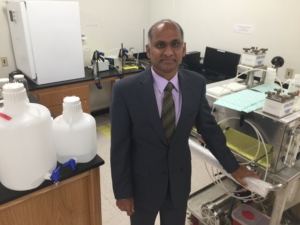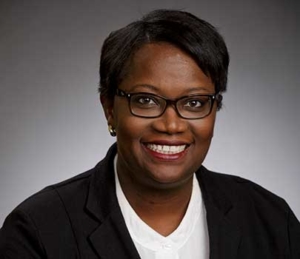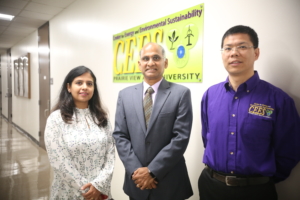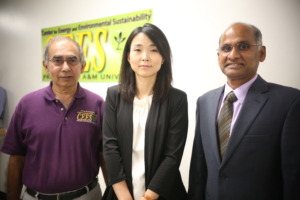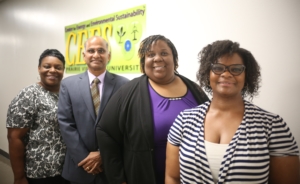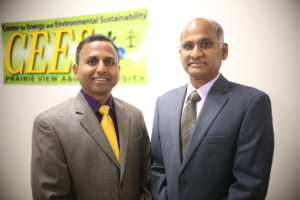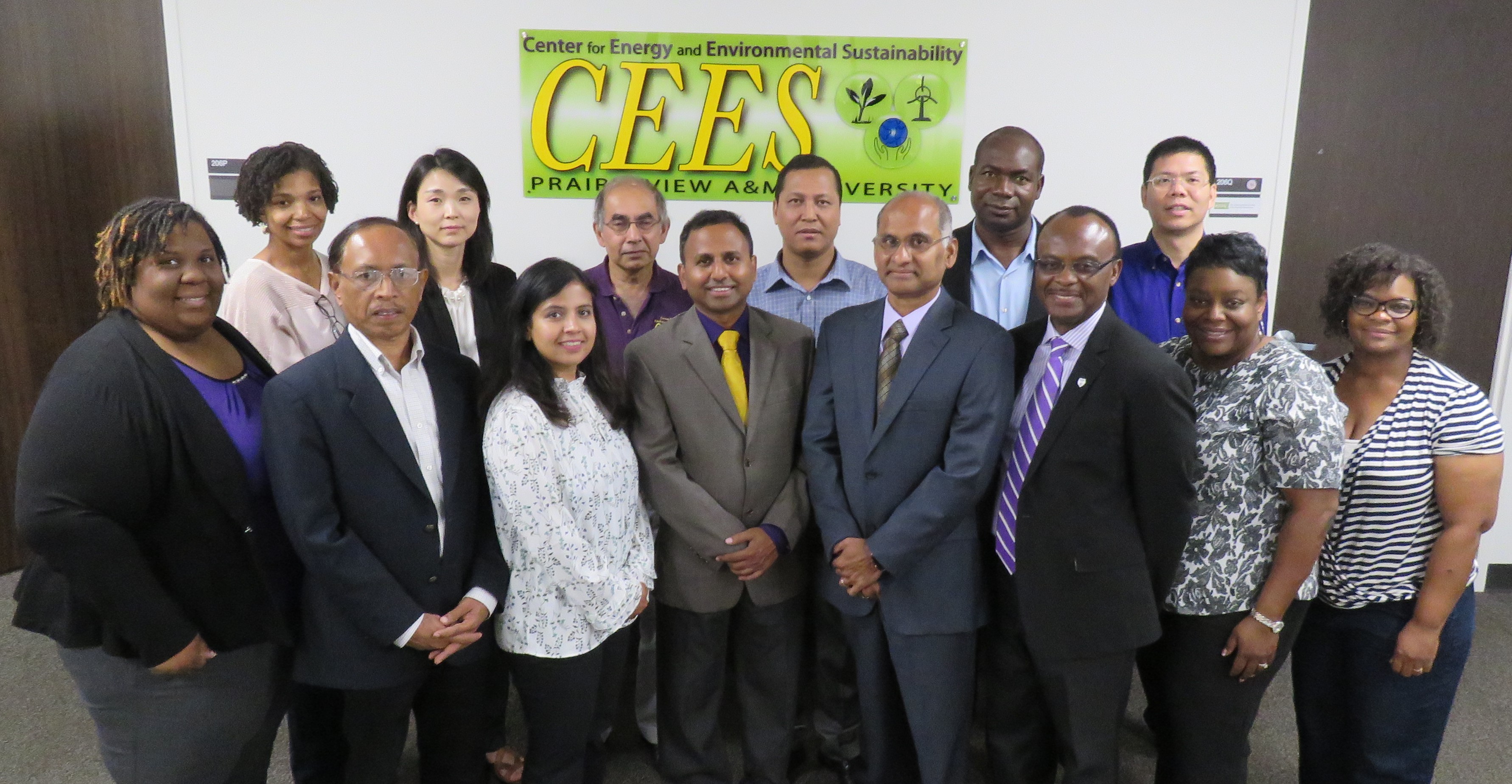
CEES Investigators – front row (left to right): Drs. Sheena M. Reeves, Ananda Amarasekara, Nabila Shamim, Magesh Rajan, Raghava R. Kommalapati, Emmanuel U. Nzewi, Sherri Frizell, and Ms. Kimberly Washington. Back row: Drs. April Lovelady, Doeun Choe, Ziaul Huque, Ripendra Awal, Peter Ampim, and Hongbo Du.
PRAIRIE VIEW, Texas (October 21, 2019) – The National Science Foundation (NSF) is fueling Prairie View A&M University (PVAMU) researchers in developing environmentally sustainable energy technologies. The NSF selected the Center for Energy and Environmental Sustainability (CEES)—which was established in 2010 as a recognized center in the Texas A&M University System—for a $5 million award.
CEES has established strong collaborative and integrated research and education programs focusing on biofuels, energy and environment, and wind energy. Professor Raghava R. Kommalapati, Ph.D., P.E., BCEE, F. ASCE, is the director of CEES and the lead researcher and primary investigator (PI) for this multilayered project. “The Center has received grants in excess of $3.7 million—that’s in addition to this Phase II grant of $5 million,” he said. “This was a competitive NSF grant proposal,” shared Pamela Holland Obiomon, Ph.D., Dean of the Roy G. Perry College of Engineering. “The faculty spent a lot of time and effort in writing the proposal to secure the $5 million, all while teaching and advising students. The team’s hard work and academic excellence paid off, and the college is very excited to receive this award.” The award will position PVAMU’s research program in renewable energy production as a national resource, enhance environmental sustainability, and transform PVAMU’s capacity to engage a diverse STEM workforce that meets the future needs of the nation. The CEES project has four goals:
- To address diverse global energy issues on renewable energy and sustainability;
- To enhance PVAMU’s prominence through infrastructure improvements, professional development, and sustaining CEES success;
- To expand collaborations in academia, the community, and the energy industry;
- And, increase enrollment of underrepresented students studying STEM (specifically energy engineering).
To achieve these goals, Kommalapati, who is also a professor in the Department of Civil and Environmental Engineering, assembled a multidisciplinary team of eleven people from three colleges at PVAMU. The group is diverse—coming from different countries, cultures, genders, ethnic backgrounds, and education institutions. They will conduct three studies, or research thrusts, and develop educational and outreach activities to promote the concept of sustainable energy. Research Teams As director and PI, Kommalapati will serve as the group leader for Environmental Sustainability. His co-PIs include Ananda Amarasekara, Ph.D., Chemistry professor and Bioenergy group leader; Doeun Choe, Ph.D., P.E., assistant professor in Civil and Environmental Engineering and technical coordinator; Professor Ziaul Huque, Ph.D., in Mechanical Engineering as Offshore Wind Energy group leader; and Sheena Reeves, Ph.D., assistant professor in Chemical Engineering who serves as Education and Outreach Coordinator. Along with the five PIs, the CEES Team also includes the following faculty from the Roy G. Perry College of Engineering: Computer Science Professor Sherri S. Frizell, Ph.D., April Lovelady, Ph.D., in Mechanical Engineering, and Nabilah Shamim, Ph.D., in Chemical Engineering. Faculty from the College of Agriculture and Human Sciences, Peter Ampim, Ph.D., and Ripendra Awal, Ph.D., and CEES Staff Postdoctoral Researcher Hongbo Du, Ph.D., and Program Coordinator Kimberly Washington are also involved. The grant will allow the researchers to broaden the research scope of PVAMU’s Centers of Research Excellence in Science and Technology (CREST) program, which provides support to enhance the research capabilities of minority-serving institutions.
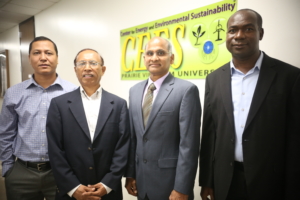
Researchers involved in the Bioenergy study include Awal, Amarasekara, Kommalapati, and Ampim. Not pictured: Lovelady.
Bioenergy Amarasekara, who joined PVAMU in 2003, said his main focus is Bioenergy. “We are looking into making renewable biofuels and bioenergy in this project. We are going to use the treated water from hydraulic fracking operations that Kommalapati will be producing in the Environmental Sustainability research group to grow energy crops. Biomass from these crops will be used to produce hydrocarbon fuels using catalysis methods,” the organic chemist explained. Amarasekara also said this study would make the campus a pioneer in this area of bioenergy research. “I am very excited. We’re the first ones,” he said. “It’s a good opportunity to train and give research experience to Prairie View students.” “We are focusing on how we can produce hydrocarbon fuels from the biomass,” explained Kommalapati. He said their goal is to be able to add hydrocarbon fuels directly to automobiles, unlike the current practice of adding biofuels, like ethanol, as additives to gas at the pumps which are produced from fossil fuels. “That’s a pretty big deal!” Kommalapati said.
Environmental Sustainability The overall goal of the Environmental Sustainability research group is to develop new treatment technologies and statistical forecasting methods and techniques to “enhance the sustainability of fossil fuel energy sources under a regime of climate variability and evolving energy portfolios.” Kommalapati said, “The research in this group includes shale gas and oil-produced water treatments using hybrid membranes; prediction of air quality trends in the context of climate change; and applying process engineering principles and stochastic methods to minimize the life cycle environmental impact of conventional fossil fuel energy sources on water and air resources.” Offshore Wind Energy
Huque shifted his study of wind energy by focusing on wind turbines that are not landlocked. “If we are able to extract energy from offshore physically and economically, our energy problems will be solved,” he said with excitement. “Right now, the offshore energy that we can tap is four times more than the current need for energy. That’s a field that will evolve.” As a structural engineer, Choe is also interested in the sustainability and reliability of offshore structures. “I have been investigating that area for at least a year or so. I’m very excited that I can do the research in which we are proposing,” she said.
Education and Outreach
Additional excitement about this energy research award is the education component for undergraduate and graduate students. “With the research, we are going to support a lot of graduate and undergraduate students to do research with faculty,” Kommalapati said, referring to the area where Reeves takes the lead as the project’s Education & Outreach Coordinator. “The exciting thing is we have the opportunity to take the information that we learn and share it with the community,” Reeves said. “That’s a major role of this particular center. It’s not just getting the information for ourselves, but we really want to disseminate that information to the local community and also to local industries.” “An NSF CREST program is one of the very good programs to help universities like Prairie View enhance its research and elevate the research infrastructure on campus,” added Magesh Rajan, Ph.D., P.E., the new Vice President of Research, Innovation, and Sponsored Programs.
“Although it has a significant research element, this particular grant will also have an education component for students majoring in engineering, science, agriculture, and other majors,” Rajan said. “This will provide participants with good, hands-on research skills. Many of them could progress into a graduate program, graduate research program, or a Ph.D. program,” Rajan shared about potential career possibilities awaiting students who participate in these projects. Obiomon says Prairie View continues to position itself as the institution of innovation and pioneers. “The global energy landscape is changing over the next decade,” she explained. “The Roy G. Perry College of Engineering is very excited to have a state-of-the-art energy center which will prepare our faculty and students to be leaders in reshaping the global energy systems.”
By Michael Douglas


